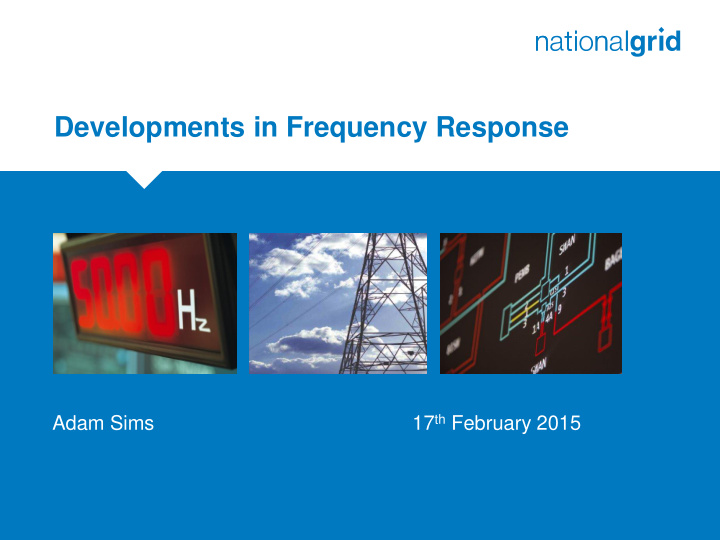



Developments in Frequency Response Place your chosen image here. The four corners must just cover the arrow tips. For covers, the three pictures should be the same size and in a straight line. 17 th February 2015 Adam Sims
Frequency Response Spend 2
Why Develop Frequency Response? System Operability Framework 2014 conclusion: System inertia is expected to reduce, requiring high RoCoF settings or alternative protection approaches Without these measures, there could be a significant increase in volume of response required Conventional plant is closing, alternative sources of response are required Need to ensure frequency response services are economic and fit for future requirements 3
Why Develop Frequency Response? High BM Holding repositioning Technically Prices costs Available Response Commercially Available Response 4
Commercially Available Response in 2013 Commercially Available Response Holding Price 5
Developments in Frequency Response Remove barriers to participation Change Response Energy Payment for low-fuel Non-BM IT project FFR bridging/growth contract Improve FFR market e-tendering Split products Weekly tenders Develop new services Rapid Frequency Response (<5s) Enhanced Frequency Control Capability (<1s) 6
Remove barriers to participation
Response Energy Payment Concerns with some wind generators pricing themselves out of the response market One reason given is the calculation of the REP, which is supposed to reflect the cost of providing the energy REP is predicated on conventional generation, i.e. where a fuel is consumed at a cost For an increase in output, generator receives MIP*1.25 For a decrease in output, generator pays MIP*0.75 For low fuel cost plant (e.g. wind) the REP calculation is not cost reflective 8
Why is this a Problem? The REP does not reflect the costs experienced by these generators in providing frequency response This is deterring participation in the response market by members of a sizeable and growing market segment Lack of liquidity in the market will result in increased balancing costs Some wind generators are pricing themselves out of the market entirely 9
Submitted Holding Price Bands (Primary) 10
Proposed CUSC Change Original Proposal: For plant with no fuel cost, the REP is settled at £0/MWh No change to plant with a fuel cost Workgroup consultation has identified a number of alternative approaches, these are now under investigation by the Workgroup Aim for Ofgem determination by summer 11
Non-BM IT Project • Limited fully integrated IT to contract, optimise, Current despatch and settle Non-BM State • Consider IT options available against the requirement to innovate and increase Non-BM balancing services Scope • Pathway to increasing National Grid’s effective use of Non-BM services Goal • IT assets for Standing Reserve Despatch (SRD) and Frequency Control by Demand Management (FCDM) Driver are limited in capability / functionally
Non-BM IT Project Lessons learnt from DSBR is that an end-to-end solution is preferred by customers Therefore the project will look to cover procurement/tendering through to settlement Requirements stage of the project started in January, due to report back in August Customer feedback is very much part of this development process 13
FFR Bridging Contract Trial bilateral Interest growth contract Lack of February from non- • 1-2 year fixed liquidity in BM launch term FFR market aggregators • Fixed price per service option 14
Improve FFR market Place your chosen image here. The four corners must just cover the arrow tips. For covers, the three pictures should be the same size and in a straight line.
FFR e-Tendering February FFR e-tendering (Ariba) • Market Day 2 nd February • No obligation at this stage to use Similar format to STOR e-tender Ability to use paper tenders initially, intention is to phase out 16
Unbundled Products Currently, tenders are for bundled products, i.e. Primary & High or Primary, Secondary & High Anecdotal evidence that there are parties who can only provide individual products Would splitting out Primary, Secondary and High increase liquidity in the FFR market? Intention to investigate this once the e-tendering platform is established (March 2015) If successful, could be considered for mandatory market 17
Weekly Tenders FFR tender is a monthly process Some providers, particularly wind, cannot predict output that far ahead This is a barrier to wind taking part in FFR We are therefore investigating moving to a weekly tender, subject to: Industry engagement e-tendering Resourcing and processes for back-office functions Aspiration to publish open letter in March 18
Develop New Services Place your chosen image here. The four corners must just cover the arrow tips. For covers, the three pictures should be the same size and in a straight line.
Rapid Frequency Response Rapid Frequency Response (<5 second response) Response of this speed may already be available from some wind farms Analysis for GCRP indicates a benefit from RFR on 60% of summer days and 24% of winter nights in 2020/21 However, no consensus at GCRP as to whether this should be a mandatory service Further Grid Code discussion due to take place in April 20
Rapid Frequency Response We believe that there is value in developing a commercial service in parallel with Grid Code discussions Areas of current work: What volumes should be sought from the market How to value it against existing services Future work: Identify technical parameters required for despatch, monitoring, settlement Seek expressions of interest from industry 21
Enhanced Frequency Control Capability The Network Innovation Commission agreed funding for a three year study on <1 second response from different types of provider Collaboration between National Grid, Centrica, Flexitricity, Alstom, Belectric and the Universities of Manchester and Strathclyde Covers conventional, wind, demand and storage providers 8 workstreams will look at everything from monitoring and control through to developing contractual terms for a new service 22
Summary Place your chosen image here. The four corners must just cover the arrow tips. For covers, the three pictures should be the same size and in a straight line.
Summary The requirement for response is increasing The volume of commercially available response is decreasing We are looking at multiple solutions to ensure secure and economic operation of the network 24
Recommend
More recommend